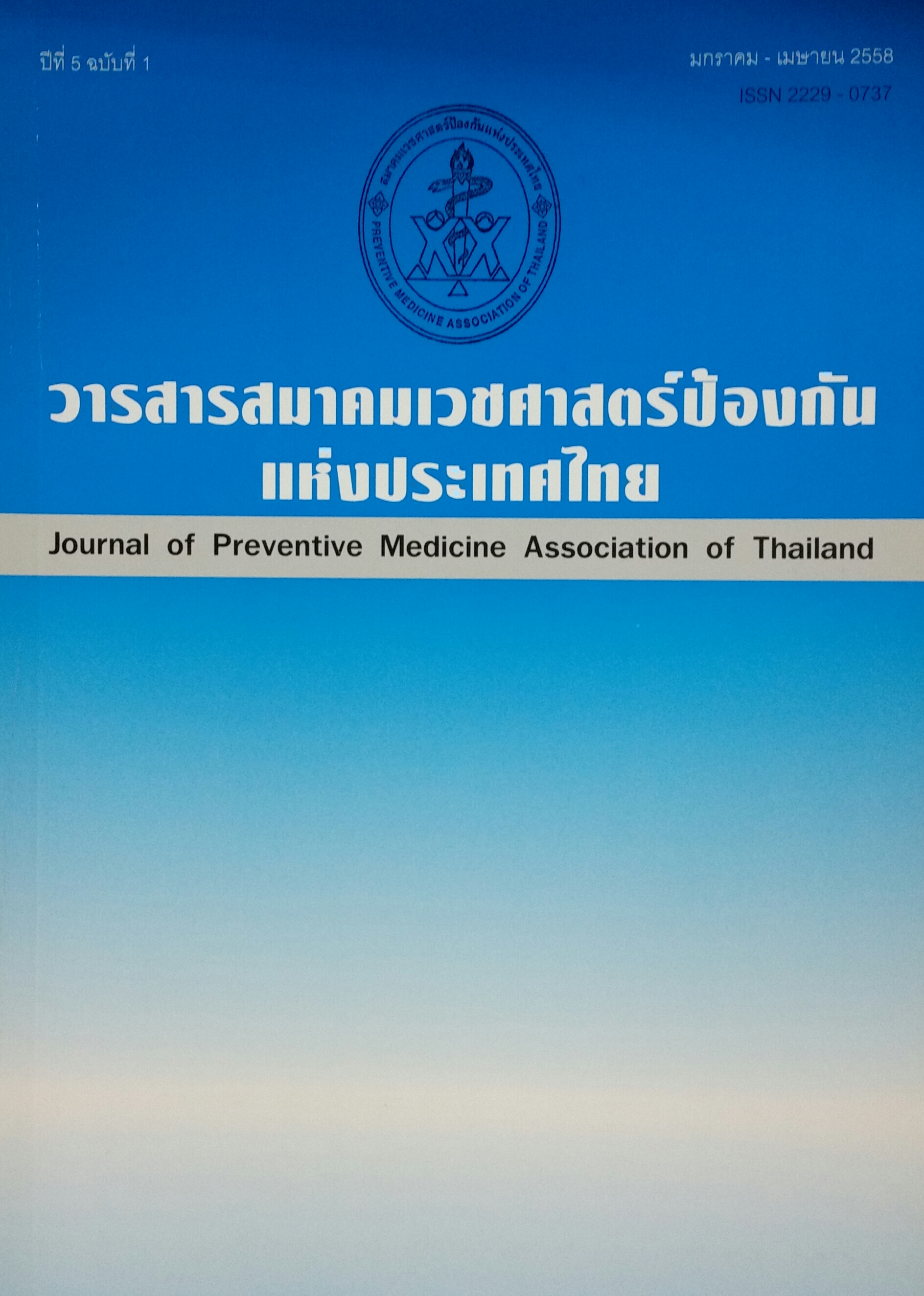The Risk Factors, Clinical Manifestations, Diagnostic Testing, and Treatments of Neonatal Sepsis in Infants Born at U-Thong Hospital, Suphanburi
Keywords:
neonatal sepsis, early-onset sepsis, late-onset sepsisAbstract
This research study was a retrospective study to determine the risk factors, clinical manifestations diagnostic testing, and treatments of neonatal sepsis in infants born at U-Thong Hospital, Suphanburi from October 1, 2011 to September 30, 2013. The patients were devided into early-onset sepsis (EOS) and late-onset sepsis (LOS) groups. Analysis was completed by percentage, mean, standard deviation, and Independent T-test to compare the differences of the studied sample. The results showed that there were 58 infants of neonatal sepsis out of a total 3,213 live births; an incidence of 18.05 per 1,000 live births. Number of infants who were diagnosed with EOS is 34 infants (58.62%) and LOS 24 infants (41.38%). The risk factors for neonatal sepsis were preterm (15.52%), low birth weight (15.52%) and maternal PROM 18 hours (8.62%). The most common clinical manifestation was fever (50.00%). The significant clinical manifestations were infant in EOS group had tachypnea (p = 0.04) and jaundice (p = 0.03) more than those in the other group but infant in LOS group had poor feeding (p = 0.00) and lethargy (p = 0.01) more than those in the other group. The common laboratory findings were leukocytosis (5.17%) and thrombocytopenia (5.17%). 5 infants had positive blood culture (8.62%). Organisms identified were Coagulase negative staphylococcus (3.45%), Staphylococcus epidermidis (3.45%) and Streptococcus viridians (1.72%). Ampicillin and gentamicin or PGS and gentamicin were first line drugs (70.69%) and the second regimen was ampicillin, gentamicin and cloxacillin or cefotaxime and amikacin (29.31%). When compared with the EOS, LOS received more cefotaxime and amikacin (p = 0.011). The average duration of antibiotic treatment was 7.10 days.
The major risk factors for neonatal sepsis in infants born at U-Thong Hospital were preterm, low birth weight and maternal PROM 18 hours. Signs and symptoms of sepsis and laboratory finding were nonspecific.The overuse broad - spectrum antibiotic was found.Guideline for preterm birth prevention, intrapartum antibiotics prophylaxis, diagnostic criteria and treatment for neonatal sepsis should be created and implement, to a reduction in the newborn sepsis admissions, expenditures for antibiotic and reduce duration of hospital stay in these infants.
References
2. Stroll BJ. Pathogenesis and Epidemiology. In : Behrman RE, Kliegman RM, Jenson HB. 19th ed. Nelson Textbook of Pediatrics. USA. Saunders, 2012:623-40.
3. Escobar GJ, Li DK, Armstrong MA, Gardner MN, Folck BF, Verdi JE, et al. Neonatal sepsis workups in infants >/=2000 grams at birth: A population-based study. Pediatrics 2000;106 (2 pt1):256-263.
4. พรเพ็ญ มนตรีศรีตระกูล, แสงแข ชำนาญวนกิจ, พรพัฒน์ รัศมีมารีย์, ปรียาพันธ์ แสงอรุณ. อุบัติการณ์ของภาวะติดเชื้อในระยะหลังคลอดลักษณะทางคลินิกและการรักษาในทารกแรกเกิดที่คลอดในโรงพยาบาลพระมงกุฎเกล้า. เวชสารแพทย์ทหารบก 2547;57:237-244.
5. Dawodu A, Umran KA, Twum-Danso K. A case control study of neonatal sepsis: experience from Saudi Arabia. J Tropical Pediatr. 1997;43(2):84-8.
6. กฤษณา เพ็งสา, สุกัญญา ทักษพันธ์. “การติดเชื้อในทารกแรกเกิด” โรงพยาบาลศรีนครินทร์ พ.ศ. 2530-2533. ศรีนครินทร์เวชสาร 2538; 10(23).
7. Tufail A, Hashmi HA. Maternal and perinatal outcome in teenage pregnancy in a community based hospital. Pakistan Journal of Surgery. 2008;24(2):130-4.
8. Chan GJ, Lee AC, Baqui AH, Tan J, Black RE. Risk of Early-Onset Neonatal Infection with Maternal Infection or Colonization: A Global Systematic Review and Meta-Analysis. PLoS Med. 2013;10(8):e1001502.
9. ชูวัฒนา ชาระ, กัลยา ศรวงค์, อมรรัตน์อินทรชื่น, สมเกียรติ นิลวัชรารัง, สมคิด สุริยเลิศ, นัทยา ก้องเกียรติกมล. ปัจจัยในหญิงตั้งครรภ์ที่มีความสัมพันธ์กับการติดเชื้อในกระแสโลหิตของทารกแรกเกิดในโรงพยาบาลนครพนม จังหวัดนครพนม. โครงการโรคติดเชื้ออุบัติใหม่ จังหวัดนครพนม.2554.
10. Brady MT, Polin RA. Prevention and management of infants with suspected or proven neonatal sepsis. Pediatrics (serial on the Internet). 2013 Jun (cited 2015 Jan 2);132(1):166-8. Available from: http://pediatrics.aappublications.org/content/early/2013/06/05/peds.2013-1310.citation
11. Polin RA; Committee on Fetus and Newborn. Management of neonates with suspected or proven early-onset bacterial sepsis. Pediatrics. 2012;129(5):1006-1015.
12. ภคินี ภัทรกุล. การติดเชื้อของทารกในโรงพยาบาลสมเด็จพระยุพราชสระแก้ว. เวชสารศูนย์การแพทย์คลินิกโรงพยาบาลพระปกเกล้า 2551;25(2):108-18.
13. Sankar MJ, Agarwal R, Deorari AK, Paul VK. Sepsis in the Newborn.Indian J Pediatric. 2008;75(3):261-6.
14. Escobar GJ, Puopolo KM, Wi S, Turk BJ, Kuzniewicz MW, Walsh EM, et al. Stratification or risk ofearly-onset sepsis in newborn > 34 weeks’ gestation. Pediatrics 2014;133(1)30-6.
15. Ottolini MC, Lundgren K, Mirkinson LJ, Cason S, Ottolini MG. Utility of complete blood count and blood culture screening to diagnose neonatal sepsis in the asymptomatic at risk newborn. Pediatr Infect Dis J. 2003;22(5):430-434.
16. Newman TB, Puopolo KM, Wi S, Draper D, Escobar GJ. Interpreting complete blood counts soon after birth in newborns at risk for sepsis. Pediatrics 2010;126(5):903-909.
17. Benitz WE, Han MY, Madan A, Ramachandra P. Serial serum C-reactive protein levels in the diagnosis of neonatal infection. Pediatrics (serial on the Internet). 1998 Oct (cited 2015 Jan 2);102(4). Available from: http://www.pediatrics.org/cgi/content/full/102/4/e41
18. Shiqiang S, GuoxianC, YidongW, LizhongD, Zhengyan Z. Rapid diagnosis of bacterial sepsis withPCR amplification and microarray hybridization in 16S rRNA gene. Pediatr Res 2005;58(1):143-8.
19. NJ Shrestha, KU Subedi, GK Rai. Bacteriological Profile of Neonatal Sepsis: A Hospital Based Study. Nepal Pediatric SocJ.2010;31(1): 1-5.
20. Marchant EA,Boyce GK,Sadarangani M, Lavoie PM. Neonatal Sepsis due to CoagulaseNegative Staphylococci. Clinical and Developmental Immunology (serial on the Internet). 2013 May (cited 2015 Jan 4). Article ID: 586076; (about 10 p.). Available from: http://dx.doi.org/10.1155/2013/586076
21. Li Z, Xiao Z, Zhong Q,Zhang Y, Xu F. 116 cases of neonatal early-onset or late-onset sepsis: A single center retrospective analysis on pathogenic bacteria species distribution and antimicrobial susceptibility. Int J ClinExp Med. 2013;6(8):693-699.
22. Nash C, Chu A, Bhatti M, Alexandar K, Schreiber M, Hageman JR. Coagulase Negative Staphylococci in the Neonatal Intensive Care Unit: Are We Any Smarter?. Neo Reviews 2013;14(6):284-293.
23. Schelonka RL, Chai MK, Yoder BA, Hensley D, Brockett RM, Ascher DP. Volume of blood required to detect common neonatal pathogens. Pediatrics. 1996;129(2):275-278.
24. จรรยา จิระประดิษฐา. ภาวะติดเชื้อในทารกแรกเกิด: หลักฐานเชิงประจักษ์. ใน: สันติ ปุณณะหิตานนท์, บรรณาธิการ. Advance Neonatal Care. กรุงเทพ : แอคทีฟพริ้นท์ จำกัด. 2556:215-236.
25. Bryan CS, John JF Jr, Pai MS, Austin TL. Gentamicin vs cefotaxime for therapy of neonatal sepsis.Relationship to drug resistance. Am J Dis Child1985;139(11):1086-1089.
26. Sivanandan S, Soraisham AS, Swarnam K. Choice and Duration of Antimicrobial Therapy for Neonatal Sepsis and Meningitis. Int J Pediatr (serial on the Internet). 2011 Nov (cited 2015 Jan 4) (about 9 p.). Available from:http://dx.doi.org/10.1155/2011/712150
Downloads
Published
How to Cite
Issue
Section
License
บทความที่ลงพิมพ์ในวารสารเวชศาสตร์ป้องกันแห่งประเทศไทย ถือเป็นผลงานวิชาการ งานวิจัย วิเคราะห์ วิจารณ์ เป็นความเห็นส่วนตัวของผู้นิพนธ์ กองบรรณาธิการไม่จำเป็นต้องเห็นด้วยเสมอไปและผู้นิพนธ์จะต้องรับผิดชอบต่อบทความของตนเอง






